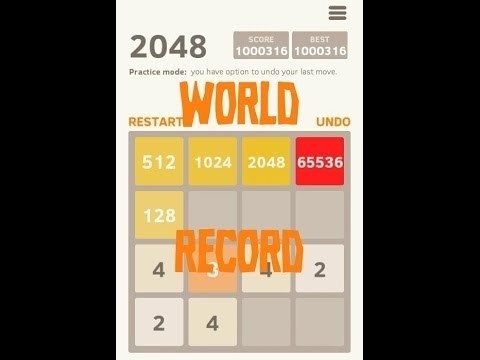2048: much harder

Assuming a perfect game, what's highest possible SCORE that can be achieved in a game of 2048 if only two's spawn.
Hint: it's not 2^16
How the game works for those who aren't familiar (although I suggest playing the game first or watching a video of it to fully understand it)
You may only combine tiles of the same number.
The grid is 4x4 and can have a maximum of 16 tiles at once.
You may not "delete" a piece from the board.
The game ends when no more tiles can be combined.
When combining two tiles of value x, the resulting tile will have a value of 2x.
Exg: if you combine two two's to make a four, then combine two more two's to create another four, then combine those two fours to get an eight, your total score will be 4+4+8=16.
When two tiles are combined, then they increase your score by the number on the new tile created.
The answer is 1835012.
This section requires Javascript.
You are seeing this because something didn't load right. We suggest you, (a) try
refreshing the page, (b) enabling javascript if it is disabled on your browser and,
finally, (c)
loading the
non-javascript version of this page
. We're sorry about the hassle.
We must evaluate the "total value" of each tile (total value meaning if you have only that tile on the board, then your total score is equivalent to the total value of that tile)
A two has a value of 0, since you don't gain any points from spawning a two.
A four has a value of 4 because you have to combine two two's and it increases your score by 4
Now it gets a little more complicated. To evaluate the value of an 8. We must start from two's. To make two fours, we already established that our score will be 8, thus after combining the two fours, our score will be increased by 8 once more. Therefore, the total value of an 8 is 16.
The total value of a 16 is then the total value of two eights +16, which sums to be 48.
We can see a pattern evolving. The total value of the tile represented by 2 n is equivalent to ( n − 1 ) ( 2 n ) .
The ideal ending scenario will be when the board looks like this
2 2 5 6 5 1 2 6 5 5 3 6 4 1 2 8 1 0 2 4 3 2 7 6 8 8 6 4 2 0 4 8 1 6 3 8 4 1 6 3 2 4 0 9 6 8 1 9 2
Thus we are looking for 1 ∑ 1 6 ( n − 1 ) ( 2 n ) = 1 8 3 5 0 1 2